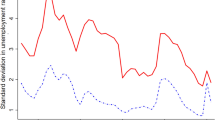Abstract
In this paper, we develop a two-country stochastic simulation model based on the theory of optimum currency areas, which studies the desirability of a monetary union. Extending the general equilibrium model of Ricci (1995), we introduce the intertemporal dimension, which allows to deal more accurately with labor mobility and shock dynamics. We analyse the importance of shocks asymmetries and investigate the role of labor mobility. Furthermore, we illustrate the influence of trade openness and the impact of a fiscal federalism system, assuming a specific transfer allocation rule based on the relative evolution of unemployment between the two countries.
Similar content being viewed by others
References
Bayoumi, T. (1994) “A Formal Model of Optimum Currency Areas.” CEPR Discussion Paper No. 968, London.
Bayoumi, T. and B. Eichengreen (1992) “Shocking Aspects of European Monetary Unification.” CEPR Discussion Paper No. 643, London.
Beetsma, R. M. and A. L. Bovenberg (1995) “Designing Fiscal and Monetary Institutions for a European Monetary Union.” CEPR Discussion Paper No. 1303, London.
Beine, M. and F. Docquier (1997) “Fédéralisme fiscal dans un modèle de zone monétaire optimale.” Revue Economique 48(3), 529–539.
Blanchard, O. and D. Quah (1989) “The Dynamic Effects of Demand and Supply Disturbances.” American Economic Review 79, 655–673.
Blanchard, O. and L. Katz (1992) “Regional Evolutions.” Brooking Papers on Economic Activity 1.
Brociner, A. and P. Levine (1992) “EMU: A Survey.” Centre for European Studies, University of Leicester, Discussion Paper No. 92/4.
De Grauwe, P. (1991) “Costs and Benefits of a Monetary Union.” T ijdschrift voor Economie en Management 36(2).
De Grauwe, P. and W. Van Haverbeke (1991) “Is Europe an Optimum Currency Area? Evidence from Regional Data.” CEPR Discussion Paper No. 555.
Eichengreen, B. (1990a) “Is Europe an Optimum Currency Area?” CEPR Discussion Paper No. 478, London.
Eichengreen, B. (1990b) “One Money for Europe? Lessons from the U. S. Currency Union.” Economic Policy 10, 117–187.
European Commission (1990) “One Market, One Money.” European Economy 44.
Fatas, A. (1997) “EMU: Countries or Regions? Lessons from the EMS Experience.” CEPR Discussion Paper No. 1558.
Fratianni, M. and J. von Hagen (1992) The European Monetary System and European Monetary Union. Oxford: Westview Press.
Isserman, A., D. Plane, P. Rogerson, and P. Beaumont (1985) “Forecasting Interstate Migration with Limited Data: A Demographic-Economic Approach.” Journal of the American Statistical Association 80, 277–285.
Isserman, A., C. Taylor, S. Gerking, and U. Schubert (1986) “Regional Labor Market Analysis.” In P. Nijkamp (ed.), Handbook of Regional and Urban Economics. Elsevier Science Publishers BV, Chap. 13, pp. 543–580.
Italianer, A. and M. Vanheukelen (1992) “Proposals for Community Stabilization Mechanisms: Some Historical Applications.” The Economics of Community Public Finance; European Economy, Special issue 5, 493–510.
Kenen, P. (1969) “The Theory of Optimum Currency Areas: An Eclectic View.” In R. Mundell and A. Swoboda (eds.), Monetary Problems in the International Economy. Chicago: University of Chicago Press.
Krugman, P. (1990) “Policy Problems of a Monetary Union.” In P. De Grauwe and L. Papademos (eds.), The European Monetary System in the 1990s.
Krugman, P. (1993) “Lessons of Massachusetts for EMU.” In Torres and Giavazzi (eds.), Adjustment Growth in the European Monetary Union. Cambridge: Cambridge University Press, pp. 241–269.
Masson, P. R. and M. P. Taylor (1992) “Common Currency Areas and Currency Unions: An Analysis of the Issues.” CEPR Discussion Paper No. 617.
McKinnon, R. (1963) “Optimum Currency Areas.” American Economic Review, 657–665.
Mélitz, J. (1991) “A Suggested Reformulation of the Theory of Optimal Currency Areas.” CEPR Discussion Paper No.590.
Mélitz, J. (1993) “The Theory of Optimum Currency Areas, Trade Adjustment and Trade.” CEPR Discussion Paper No. 847.
Mélitz, J. (1995) “The Current Impasse in Research on Optimum Currency Areas.” European Economic Review 39, 492–500.
Muet, P. A. (1995) “Union monétaire et fédéralisme.” Revue de l’OFCE 55, 151–170.
Mundell, R. (1961) “A Theory of Optimum Currency Areas.” American Economic Review 715–725.
Ricci, L. A. (1995) “A Simple Model of an Optimum Currency Area.” Paper presented at the Journées de l’AFSE, Nantes.
Sachs, J. and X. Sala-I-Martin (1992) “Fiscal Federalism and Optimum Currency Areas: Evidence for Europe from the United States.” CEPR Discussion Paper No. 632.
von Hagen, J. and G. W. Hammond (1995) “Regional Insurance against Asymmetric Shocks. An Empirical Study for the European Community.” CEPR Discussion Paper No. 1170.
Author information
Authors and Affiliations
Rights and permissions
About this article
Cite this article
Beine, M., Docquier, F. A Stochastic Simulation Model of an Optimum Currency Area. Open Economies Review 9, 229–257 (1998). https://doi.org/10.1023/A:1008216701051
Issue Date:
DOI: https://doi.org/10.1023/A:1008216701051




